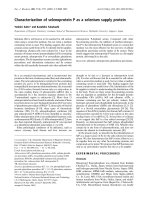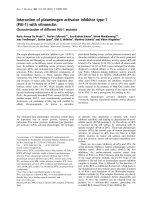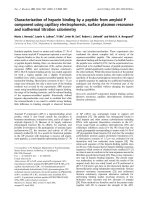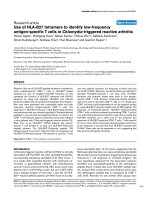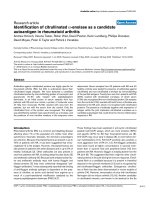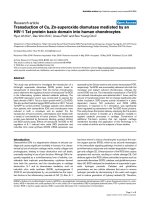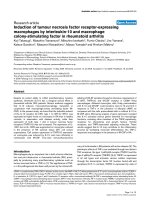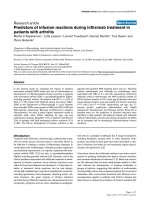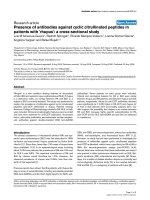Báo cáo y học: " Detection of porcine parvovirus using a taqman-based real-time pcr with primers and probe designed for the NS1 gene" doc
Bạn đang xem bản rút gọn của tài liệu. Xem và tải ngay bản đầy đủ của tài liệu tại đây (309.77 KB, 4 trang )
SHORT REPOR T Open Access
Detection of porcine parvovirus using a
taqman-based real-time pcr with primers and
probe designed for the NS1 gene
Cuiping Song
1,2†
, Chao Zhu
3†
, Chaofan Zhang
3
, Shangjin Cui
3*
Abstract
A TaqMan-based real-time polymerase chain reaction (PCR) assay was devised for the detection of porcine parvo-
virus (PPV). Two primers and a TaqMan probe for the non-structural protein NS1 gene were designed. The detec-
tion limit was 1 × 10
2
DNA copies/μL, and the assay was linear in the range of 1 × 10
2
to 1 × 10
9
copies/μL. There
was no cross-reaction with porcine circovirus 2 (PCV2), porcine reproductive and respiratory syndrome virus
(PRRSV), pseudorabies virus (PRV), classical swine fever virus (CSFV), or Japanese encephalitis virus (JEV). The assay
was specific and reproducible. In 41 clinical samples, PPV was detected in 32 samples with the real-time PCR assay
and in only 11 samples with a conventional PCR assay. The real-time assay using the TaqMan-system can therefore
be practically used for studying the epidemiology and management of PPV.
Introduction
Porcine parvovirus (PPV) i s an autonomous parvovirus
belonging to t he genus parvovirus, subfamily Parvoviri-
nae,familyParvoviridae. It is one of the major etiologi-
cal agents of reproductive failure in pigs. Reproductive
failure caused by PPV is characterized by embryonic
and foetal death, mummification, stillbirth, and delayed
return to oestrus [1]. I n addition, PPV has been impli-
cated as the causative agent of diarrhea, skin disease,
and arthritis in swine [2]. PPV has been reported from
many different countries [3-5].
PPV is composed of a linear single-stranded segment
of DNA approximately 5 kb long (Molitor, T.W., 1983),
and its g enome has more than two open reading frames
(ORF) [6]. The 3’ end of ORF1 encodes nonstructural
proteins (NS proteins), and the 5’ end of ORF2 encodes
structural proteins (VP proteins).
For diagnostic purposes, PP V can be rapidly and sensi-
tively detected with polymerase cha in reaction (PCR) assays
[7,8]. However, current PCR assays for PPV often require
multiple steps and d o not provide quantitative data.
In contrast, real-time PCR using S Y BR Green and TaqMan
is rapid, specific, and efficient for the large-scale screening,
strain id entification, and quantification of PPV [ 9].
NS1, which is encoded by the NS1 gene, is a main
nonstructural protein of PPV and is associated with the
early and late transcription of the virus. Given that inac-
tivated virus used in current vaccines have only little
NS1 protein which could not produce antibody, the pre-
sence or absence of antibody against NS1 protein could
be used in an NS1-based d iagnostic kit for determining
in clinical settings whether pigs have been vaccinated
with the inactivated-PPV or infected with wild-type
PPV, and the test would give a negative result for for
vaccinated/noninfected pigs. NS proteins are also impor-
tant in virus research because they play an important
regulatory role in viral replication even though they do
not directly participate in the assembly of virus particles.
In this study, a T aqMan-based real-time PCR assay
was developed for the rapid and quantitative detection
of PPV with a probe specific for the PPV NS1 gene. The
results of the real-time PCR assays were compared with
those of previously established, conventional PCR assays.
Materials and methods
Primers and probes
PCR primers and a TaqMan probe, which were designed
with the p rogram DNAStar and synthesized by Saituo
* Correspondence:
† Contributed equally
3
Division of Swine Infectious Disease, State Key Laboratory of Veterinary
Biotechnology, Harbin Veterinary Research Institute of CAAS, Harbin, China
150001
Full list of author information is available at the end of the article
Song et al. Virology Journal 2010, 7:353
/>© 2010 Song et al; licensee BioMed Central Ltd. This is an Open Access article distributed under the terms of the Creative Commons
Attribution License ( which permits unrestricted use, distribution, and reproduction in
any medium, provided the original work is properly cited.
Matrix Biotechnology (Haerbin) Co., Ltd, were used
to amplify a 123-bp fragment of the NS1 gene. The
sequences of the primers and probe were:
NS1-FP (forward primer): 5’-GAAGACTGGATGATGA-
CAGATCCA-3’,
NS1-RP (reverse primer): 5’-TGCTGTTTTTGTTCT
TGCTAGAGTAA-3’.
NS1-P (probe): FAM-AATGATGGCTCAAACCG-
GAGGAGA-BHQ1. The probe was labeled with 6-
carboxyfluor escein (FAM) at the 5’-end and with BHQ1
at the 3’-end.
Preparation of standard plasmid DNA
PCR amplification of the NS1 gene was carried out in a
reaction mix of 25 μL: 16.0 μLsterilizedwater,2.5μLof
10× buffer, 3.0 μL of dNTP, 1 μL of each primer (NS1-FP
and NS1-RP), 1 μLofBQstrainDNA,and0.5μLofEx
Taq™ DNA Polymerase (Ex taq). The thermal conditions
were as follows : one cycle at 94 C for 5 min; fol lowed by
30 cycles at 94 C for 30 s, 58 C for 45 s, and 72 C for 30
s; with a final extension at 72 C for 7 min.
The PCR product was inserted into a vector, pMD18-T
(TaKaR a Biote chnology (Dalian) Co., Ltd.). After the cul-
ture was increased in DH5a host bacteria (TaKaRa Bio-
technology Co., Ltd), the recombinant plasmid was
purified using a commercial test kit (Watson Biotechnol-
ogies, Inc.). The products were kept at -20°C for later use.
Establishment of real-time PCR
The real-time PCR amplifications of the NS1 gene used
25-μL reaction mixtures containing 2.5 μL of 10× buffer,
3.5 μL of dNTP (TaKaRa Biotechnology Co., Ltd), 3 μL
of MgCl
2
,1μL of each primer (10 pM/μLofNS1-FP
and NS1-RP), 1 μL of the recombinant plasmid, 0.5 μL
of the probe (PPV-P), 0.5 μL of Hotstar taq (TaKaRa
Biotechnology Co., Ltd), and 12.0 μL sterile water. The
reactions were carried out in an Rotor-Gene Thermocy-
cler (Corbett Research. Co. Ltd.). The conditions were
as follows: one cycle at 95°C for 30 s follow ed by 40
cycles at 95°c for 10 s, 5 8°c for 20 s, and 72 °C for 20 s.
The data were analyzed with the Rotor-Gene software.
Sensitivity of the real-time PCR
To determine the detection limit and efficiency of the
assay, recombinant pl asmid of standard DNA was used
as a template and was 10-fold serially diluted with sterile
water, giving 6.00 × 10
9
to 6.00 × 10
1
copies/μL. The
sensitivity of the real-time PCR was compared with con-
ventional PCR (Yue et al., 2009).
Specificity of the real-time PCR
To determine the specificity of the real-time PCR, the
standard plasmid-positive template and different strains
of PPV, five different viruses (PRRSV, CSFV, P RV, JEV,
and PCV-2), and control (sterile water) were processed
with the real-time PCR.
Reproducibility of real-time PCR
To determine the reproducibility of the real-time PCR,
the standard plasmid was diluted to 6 .00 × 10
8
,6.00×
10
6
,6.00×10
4
, and 6.00 × 10
2
copies/μL. To obtain
variation within an assay (within a block), each dilution
was processed four different times, i.e., in f our blocks,
with the real-time PCR assay. Each block contained four
repeated determinations for each dilution, giving 16
total determinations for each dilution. Coefficients of
variation (CVs) for Ct values within each block and
among blocks (using the mean values from each block)
were determined.
Detection of the clinical samples
Forty-one clinical samples (20% organ suspensions
stored at -70°C) that were suspected of being infected
with PPV were subjected to the real-time PCR and con-
ventional PCR.
Results
Establishment of the standard plasmid-positive template
The amplified NS1 gene fragment was about 123 bp
long. The plasmid DNA concentration was 0.189 μg/μL
before dilution. So, the DNA concentration was equiva-
lent to 6.00 × 10
10
copies/μL before dilution.
Establishment of a standard curve for the real-time PCR
The standard curve was generated with a range of 6.00
×10
9
to 6.00 × 10
2
copies/μL (Figure 1A). The assays
were linear in a dilution range of template DNA from
6.00 × 10
2
to 6.00 × 10
9
copies/μL, with R
2
values of
0.996 and reaction efficiencies of 100% for NS1. Quanti-
tative data for Cycling A. FAM are shown in Figure 1B.
The amplification product was about 123 bp long, and
no false amplification was observed.
Sensitivity of the real-time PCR
The detection limit of the real-time PCR for the NS1
gene of PPV was 1.00 × 10
2
copies/μL(Figure 1B). The
conventional PCR assay showed a negative result when
the solution was diluted to 1.00 × 10
4
copies/μL. These
results indicate that, based on direct observation, the
sensitivity of the real-time PCR is 100 times greater
than that of the conventional PCR (Figure 1C).
Specificity of the real-time PCR
The real-time PCR gave positive results for the standard
plasmid of PPV strains (6.00 × 10
8
copies/μL) and nega-
tive results for the other porcine viruses involved in
reproductive disorders (PCV2, PRV, PRRSV, CFSV, a nd
JEV) and for the sterile water control (Figure 1D).
Song et al. Virology Journal 2010, 7:353
/>Page 2 of 4
Reproducibility of the real-time PCR
When the serially diluted standard plasmid (6.00 × 10
8
,
6.00 × 10
6
,6.00×10
4
, and 6.00 × 10
2
copies/μL) was
subjected to the real-time PCR, the within-block CV
value (four replicate assays for each dilution performed
at one time) and the among-block CV value (the means
of four replicates from each of four times) were rela-
tively small (Table 1).
Detection of PPV in clinical samples by real-time PCR and
conventional PCR
Real-time PCR and conventional PCR were used simul-
tan eously with 41 samples that had been collected from
several swine herds for diagnostic purposes. Real-t ime
PCR detected PPV in 32 samples and conventional PCR
detected PPV in 11 samples; therefore, they were 100%
sensitivity and 100% specificity (Table 2).
Discussion
This study describes a real-time PCR assay for PPV
based on detection of the NS1 gene. The real-time PCR
assay was 100 times more sensitive than conv entional
PCR. The assay was specific in that it provided positive
results with differe nt strains of PPV but negative results
with other viruses (PCV2, PRV, PRRSV, CFSV, JEV)
associated with reproductive disorders of swine. The
real-time PCR assay was also highly reproducible.
The real-time PCR method has several advantages for
detection of PPV. First, the real-time PCR is more sensi-
tive than conventional PCR, and high sensitivity is
required for early diagnosis of PPV in the clinic. Second,
the real-time PCR is faster than conventional PCR
because it does not require gel electrophoresis. Third,
the TaqMan real-time PCR described here is less likely
toproduceafalsepositivethanaconventionalPCR
assay or t he SYBR Green I-based real-time PCR. Taq-
Man-based real-time PCR may be more specific than
SYBR Green I-based rea l-time PCR because the former
requires specific probes that bind with PPV DNA tem-
plate, while the latter uses probes that can bind to any
double-stranded DNA, even non-specific amplicons.
Design of the primers and probe was based on the
NS1 region of the PPV genome because this region is
highly conserved. NS1 protein is believed to be a bifunc-
tional protein with ATPase and helicase activities. In all
parvoviral DNAs, both the 5’-and3’-terminal palindro-
mic sequences act as primers during replication [10].
Conclusion
In conclusion, the TaqMan real-time PCR assay has
been shown to be rapid , sensitive, specific, and reprodu-
cible for the detection and quantification of PPV. It
should be an excellent tool for laboratory detection of
PPV in tissue-culture samples as well as in field samples.
Figure 1 Establishment of real-time PCR.A.Standardcurves
(based on plasmid DNA) indicating the linearity and efficiency for
detecting NS1 by real-time PCR. The x-axis represents copies of
plasmid DNA in 10-fold dilutions, and the y-axis represents the
fluorescence data used for cycle threshold (Ct) determinations. The
assays were linear in the range of 10
9
to 10
2
template copies/μL,
with an R
2
of 0.996 and a reaction efficiency of 100% for NS1. B.
The results of the Quantitation data for Cycling A. FAM. The
amplification product was about 123 bp long, and no false
amplification was observed. The detection limit of the real-time PCR
for the NS1 gene of PPV was 1.00 × 10
2
copies/μL. C. Sensitivity of
normal PCR. N: Negative Control. M: DNA marker DL2000. Lane 1-9:
The standard plasmid was 10-fold serially diluted as template. D.
Specificity of the real-time PCR assay. PPV:Positive sample; A-F:
Negative control, PCV2, PRV, PRRSV, CFSV, JEV, and H
2
O control.
Table 1 Coefficients of variation for the real-time PCR for PPV-NS1 performed for four concentrations of the standard
plasmid at one time (one block with four replications per concentration) or at four different times (four blocks)
Within one block or among four blocks Concentration of standard plasmid (copies/μL) n Ct
(mean)
S.D. CV (%)
Within 6.0 × 10
8
4 17.67 0.38 2.15
Within 6.0 × 10
6
4 24.38 0.53 2.17
Within 6.0 × 10
4
4 30.23 0.44 1.46
Within 6.0 × 10
2
4 37.18 0.36 0.97
Among 6.0 × 10
8
4 17.35 0.04 0. 21
Among 6.0 × 10
6
4 24.30 0.14 0. 57
Among 6.0 × 10
4
4 30.83 0.14 0. 46
Among 6.0 × 10
2
4 37.80 0.16 0. 42
Song et al. Virology Journal 2010, 7:353
/>Page 3 of 4
TheTaqManreal-timePCRassaywillbeusefulfor
studying the molecular epidemiology of PPV infections
in swine populations. The assay will also be very useful
for early diagnosis of PPV and therefore for manage-
ment of PPV.
Acknowledgements
The study was supported in part by funding from the National High-tech
R&D Program (863 Program-2007AA100606) and the Chinese National Key
Laboratory of Veterinary Biotechnology Fund (NKLVBP201002).
Competing interests
The authors declare that they have no competing interests.
Authors’ contributions
CPS and CZhu carried out the molecular probe studies, and drafted the
manuscript. CZha participated in the design of the study and perform ed the
statistical analysis. SC conceived of the study, and participated in its design
and coordination. All authors read and approved the final manuscript.
Author details
1
Laboratory of Marine Genetics and Breeding (MGB), Ocean University of
China, Qingdao 266003, China.
2
China Animal Health and Epidemiology
Center, Qingdao 266032, China.
3
Division of Swine Infectious Disease, State
Key Laboratory of Veterinary Biotechnology, Harbin Veterinary Research
Institute of CAAS, Harbin, China 150001.
Received: 2 June 2010 Accepted: 2 December 2010
Published: 2 December 2010
References
1. Mengeling WL: Porcine parvovirus. In Diseases of Swine. Ninth edition.
Edited by: Straw BE, Zimmerman JJ, D’Allaire S, Taylor DJ. Black-well
Publishing, Ames, IA; 2006:93-1400.
2. Hong-Ying Chen, Xiao-Kang Li, Bao-An Cui, Zhan-Yong Wei, Xin-Sheng Li,
Yan-Bin Wanga, Li Zhaoa, Zhen-Ya Wanga: A TaqMan-based real-time
polymerase chain reaction for the detection of porcine parvovirus.
Journal of Virological Methods 2009, 84-88.
3. Mengeling WL, Lager KM, Zimmerman JK, Samarikermani N, Beran GW: A
current assessment of the role of porcine parvovirus as a cause of fetal
porcine death. J Vet Diagn Invest 1991, 3:33-35.
4. Kim J, Chae C: A comparison of virus isolation, polymerase chain
reaction, immunohistochemistry, and in situ hybridization for the
detection of porcine circovirus 2 and porcine parvovirus in
experimentally and naturally coinfected pigs. J Vet Diagn Invest 2004,
16(1):45-50.
5. Zeeuw EJ, Leinecker N, Herwig V, Selbitz HJ, Truyen U: Study of the
virulence and cross-neutralization capability of recent porcine parvovirus
field isolates and vaccine viruses in experimentally infected pregnant
gilts. J Gen Virol 2007, 88:420-427.
6. Shackelton LA, Hoelzer K, Parrish CR, Holmes EC: Comparative analysis
reveals frequent recombination in the parvoviruses. J Gen Virol 2007,
88:3294-3301.
7. Molitor TW, Joo HS, Collet MS: Porcine parvovirus Virus purification and
structural and antigenic properties of viron polypeptides. Virology 1983,
45:842-854.
8. Soares RM, Durignon EL, Bersano JG, Richtzenhain LJ: Detection of porcine
parvovirus DNA by the polymerase chain reaction assay using primers
to the highly conserved nonstructural protein gene, NS-1. J Virol Methods
1999, 78:191-198.
9. Wilhelm S, Zeeuw EJ, Selbitz HJ, Truyen U: Real-time PCR protocol for the
detection of porcine parvovirus in field samples. J Virol Methods 2006,
134:257-260.
10. Astell CR, Thomson M, Chow MB, Ward DC: Structure and replication of
minute virus of mouse DNA. Cold Spring Harb Sym Quant Biol 1983,
47:751-762.
doi:10.1186/1743-422X-7-353
Cite this article as: Song et al.: Detection of porcine parvovirus using a
taqman-based real-time pcr with primers and probe designed for the
NS1 gene. Virology Journal 2010 7:353.
Submit your next manuscript to BioMed Central
and take full advantage of:
• Convenient online submission
• Thorough peer review
• No space constraints or color figure charges
• Immediate publication on acceptance
• Inclusion in PubMed, CAS, Scopus and Google Scholar
• Research which is freely available for redistribution
Submit your manuscript at
www.biomedcentral.com/submit
Table 2 Detection of PRRSV in 41 clinical samples by
real-time PCR vs. conventional PCR
Conventional PCR
Positive Negative
Real-time PCR
Positive 11
a
21
c
Negative 0
b
9
d
a,d
indicate the number of samples that generate d similar data for both
assays.
b,d
indicate the number of samples that generated different data for the
assays.
Song et al. Virology Journal 2010, 7:353
/>Page 4 of 4
